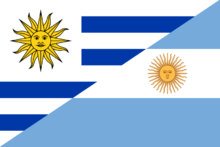Argentinos en Uruguay | |
|---|---|
 | |
| Total population | |
| 137.501 [1] | |
| Regions with significant populations | |
| Montevideo · Punta Del Este · Colonia del Sacramento | |
| Languages | |
| Rioplatense Spanish | |
| Religion | |
| Roman Catholicism | |
| Related ethnic groups | |
| Other Brazilians in Uruguay, |
Argentine Uruguayans are people born in Argentina who live in Uruguay. In 2010, there were over 10,000 Argentines living in Uruguayan territory. [2]
Overview
Many Argentine-born persons reside in Uruguay, for a number of reasons. Both countries share the same language, culture and ethnicity and their populations bear striking similarities; the historical origins of both nations is common (part of the Viceroyalty of the River Plate, Spanish Empire); both countries are members of MERCOSUR, there is no need for special migration documents, and circulation is relatively easy. Uruguay is a small, quiet country, with wide beaches on the Atlantic Ocean, so many Argentines choose Uruguay as their usual holiday destination, some of them even as permanent residence; [3] Argentine people come to Uruguay in search of a better quality of life. [4] The Uruguayan resort Punta del Este is famous as "the biggest Argentine seaside resort". [5]
The 2011 Uruguayan census revealed 26,782 people who declared Argentina as their country of birth. [6] In 2013, there were almost 6,000 Argentine citizens registered in the Uruguayan social security. [7]
Argentines in Uruguay have their own institutions, such as the Uruguayan-Argentine Institute, a bilingual school in Punta del Este. [8]
In 2022, It was confirmed Colonia was going to make a Silicon Valley in Colonia called 'Colonia Ala Este' to bring more Argentine immigrants due to the bad economy in Argentina doubling their population making their goal reach to about 60,000 people in total in Colonia. With an initial investment of more than US$ 100 million, it was planned to build a sustainable city open to the community to generate a hub for the knowledge economy industry on a 500-hectare site, which includes forests and seven kilometers of coastline. with beaches such as Calabrés and Fernando. [9]
Notable people
- past
- Torcuato de Alvear (1822-1890), politician, son and father of presidents of Argentina
- Virginia Bolten (1870-1960), activist
- Manuel Arturo Claps (1920-1999), writer, member of the Generation of 45
- Esteban Echeverría (1805-1851), poet, writer, and political activist
- Matilde Ibáñez Tálice (1907-2002), First Lady of Uruguay as wife of President Luis Batlle Berres, and mother of President Jorge Batlle Ibáñez
- Tristán Narvaja (1819-1877), legal scholar, compiler of the Uruguayan Civil Code
- José Rondeau (1773-1844), general, Provisional Governor and Captain General of Uruguay (1828)
- Alberto Zum Felde (1887-1976), historian, essayist and critic
- present
- Thelma Biral, actress, studied with Margarita Xirgu and started her theatre career in Montevideo
- Julio Bocca, ballet dancer, current director of SODRE National Ballet
- Martín Bonjour, footballer
- Emiliano Brancciari, musician
- Roberto Reinaldo Cáceres González, bishop emeritus of Melo
- Gustavo Cordera, musician, frontman of the band Bersuit Vergarabat
- Cacho de la Cruz, television presenter
- Carlos María Domínguez, journalist
- Marcos Galperin, businessman, founder and CEO of MercadoLibre [10]
- Macarena Gelman, politician, granddaughter of poet Juan Gelman
- Gabriel Migliónico, footballer
- Mónica Navarro, singer and actress
- Daniel Pereira, footballer
See also
References
- ^ "Encuesta Nacional de Hogares Ampliada 2006" [Extended National Household Survey 2006] (in Spanish). 2007. Archived from the original on 11 May 2012. Retrieved 22 October 2011.
- ^ Perfil migratorio de Argentina 2012 (PDF). Buenos Aires: International Organization for Migration. 2012. p. 184. ISBN 978-92-9068-657-6. Retrieved 2 March 2013.
- ^ "Foreign residents in Punta del Este". El Observador. 28 November 2013. Archived from the original on 4 December 2013. Retrieved 28 November 2013. (in Spanish)
- ^ "A light on the other side of the river". La Nación. 22 February 2014. (in Spanish)
- ^ "Argentine settlers in Punta del Este increasing". El Observador. 27 January 2013. Archived from the original on 29 October 2013. Retrieved 26 October 2013.(in Spanish)
- ^ "Immigration to Uruguay" (PDF). INE. Retrieved 6 March 2013. (in Spanish)
- ^ "Foreign workers in Uruguay". EL PAIS. Archived from the original on 5 November 2013. Retrieved 4 November 2013. (in Spanish)
- ^ IUA Archived 2014-03-31 at the Wayback Machine (in Spanish)
- ^ "+Colonia: la "ciudad del futuro", cruzando el charco". 2022. Retrieved June 30, 2022.
- ^ ElPais. "Fundador de Mercado Libre renunció a la presidencia y decidió vivir en Uruguay". Diario EL PAIS Uruguay (in Spanish). Retrieved 2021-11-20.
